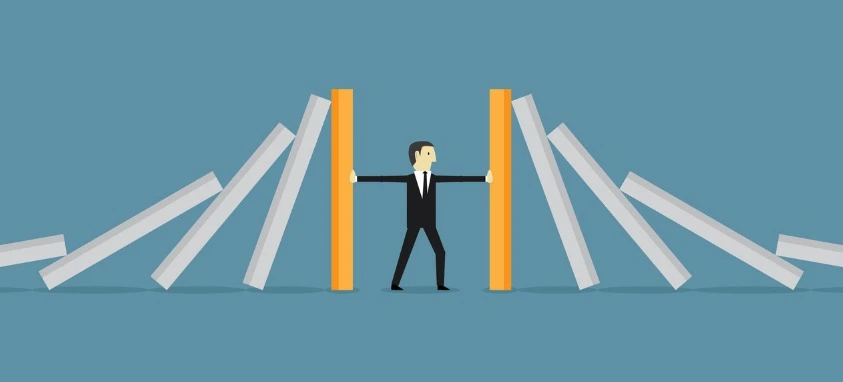Have you ever wondered how to protect your company from unexpected threats? This is the core of crisis management, a strategic process designed to handle sudden events that threaten a company’s stability and reputation.
In this article, we’ll discuss the importance of crisis management for enterprises that are small and medium-sized, clarify the difference between it and risk management, and then explore its key types and phases.
Why Is Crisis Management Important for SMEs in the UAE?
Let me start this article with defining the concept of crisis management, before we mention their importance for SMEs in the UAE.
Crisis management can be defined as a strategic plan that you design to handle any sudden and unexpected events that may put threats on your company’s stability and reputation.
You can’t say that crisis management is a quick reaction to a specific threat, because in fact it is a multi-stage process that includes proactive planning, thorough analysis, and the implementation of specific actions.
You should know that crisis management’s main goal is to turn difficult situations into opportunities for learning and growth while protecting your company’s key assets—be they physical, human, or intellectual.
Crisis management is vital for SMEs in the UAE, especially given their limited resources, which make them more vulnerable to both internal and external crises.
A clear crisis management strategy is therefore essential, and its importance is highlighted by the following:
- Protecting Reputation and Building Trust: Internal or external crises can significantly harm your company’s reputation, especially in a competitive market like the UAE.
A strategic plan for crisis management helps your company effectively handle these problems, preserving the trust of customers, partners, and employees.
- Ensuring Business Continuity: A work stoppage caused by a crisis can be catastrophic for an SME, sometimes even leading to business liquidation.
A well-defined crisis plan helps the company recover quickly from challenges, whether internal or external, such as natural disasters or technical issues, ensuring the continuation of core operations with minimal disruption.
- Limiting Financial Losses: Crises often cause significant financial losses for SMEs.
However, with a clear crisis plan, companies can mitigate physical damages, avoid lost revenue, and reduce the costs of repairs or compensation.
- Boosting Employee Confidence: Having a strong, well-prepared plan to protect employees boosts loyalty and fosters a positive and resilient work environment.
Given these numerous benefits, it’s crucial to start thinking about a robust plan to face any future crises, whether internal or external.
What’s the Difference Between Crisis Management and Risk Management?
If you think risk management and crisis management are two sides of the same coin, they are, in fact, quite different, yet they complement each other. The relationship between them can be likened to the relationship between preventing a disaster and treating it after it has occurred. Let me explain the difference.
Similarities Between Risk Management and Crisis Management
Despite their core differences, they share several key points:
- General Objective: Both aim to protect the company from potential or actual threats, preserve its financial stability, and safeguard its reputation and assets.
- Dealing with Uncertainty: Both fields involve handling uncertain or unexpected events that could negatively impact operations.
- Strategic Planning: Both require meticulous planning and the development of specific strategies to ensure business continuity.
- Analytical Component: Both rely on analyzing and evaluating situations to determine the best course of action.
Key Differences Between Crisis Management and Risk Management
Here, i will tell you the main differences between Crisis and risk management, as follows:
- Timing:
- Risk Management: A proactive process that focuses on predicting potential future risks and creating plans to prevent or mitigate their impact.
- Crisis Management: A reactive process that begins when a crisis has already occurred, requiring an immediate and rapid response to contain the situation.
- Objective:
- Risk Management: Its goal is to prevent problems by identifying vulnerabilities and implementing preventive measures.
- Crisis Management: Its goal is to control the damage caused by a crisis and minimize its negative impact as much as possible.
- Scope:
- Risk Management: Deals with a wide range of potential events—financial, operational, technological, or even environmental.
- Crisis Management: Focuses on one specific, real-world event and requires a swift, targeted response.
- Outcome and Impact:
- Risk Management: Helps reduce the likelihood of a crisis occurring in the first place.
- Crisis Management: Aims to lessen the severity of a crisis and return to normal situation as quickly as possible after it has occurred.
In short, risk management is the process of planning for “what if this happens?”, while crisis management is the process of responding to “this happened, now what?”.
What Are the Types of Crisis Management?
Companies can face many different types of crises. Understanding them is a fundamental step toward preparing for and dealing with them effectively. The following are the most important types of crises that require specific management plans:
- Natural Crisis Management: Deals with crises resulting from natural causes such as floods, earthquakes, hurricanes, and pandemics.
These crises require a rapid response to ensure the safety of people and the protection of a facility’s physical assets.
- Technological Crisis Management: Arises from system failures or cybersecurity attacks, such as data breaches, server crashes, or network outages.
This type of crisis has become more common with increased reliance on technology and requires plans to protect data and restore damaged systems.
- Human Resources Crisis Management: Includes crises related to a company’s workforce, whether due to labor disputes, strikes, the sudden departure of key employees, or serious internal issues that affect the work environment and productivity.
- Financial Crisis Management: Occurs when a company’s financial stability is threatened, as a result of a market crash, a liquidity crisis, or a sharp drop in revenue.
This requires a rapid response to protect financial assets and ensure the continuity of operations.
- Organizational Crisis Management (Reputation Crisis): Results from misconduct, unethical decisions, or internal violations.
These crises do not only cause major damage to your company’s reputation, but also negatively affect the trust of your customers and investors, which requires urgent plans to rebuild trust and correct the course.
As a result of the differences between these types of crises, it is important to have different strategies specifically designed to contain the damage from each and restore the situation to normal.
What Are the Key Stages of Crisis Management?
Crisis management involves several key phases, which can be categorized into five stages that begin before a crisis occurs and continue after it, according to the founder of this model, Ian Mitroff.
- Signal Detection and Early Warning: This is the most crucial stage, focusing on identifying early signs of a potential crisis to analyze them before they escalate into a real problem.
Examples include increasing customer complaints, recurring minor technical issues, or internal rumors.
- Preparation and Prevention: This stage immediately follows the first one and involves creating clear crisis management strategies, training employees on their roles and responsibilities, and conducting simulated scenarios.
- Damage Containment and Control: When a crisis occurs, this stage is the focus of the response.
It requires swift and effective action to contain the damage and prevent it from worsening.
This includes activating the emergency plan, communicating transparently with stakeholders (customers, employees, media), and taking necessary measures to minimize losses.
- Recovery: After the immediate crisis is under control, the recovery stage begins.
It focuses on restoring normal operations as quickly as possible, repairing physical damage, and regaining public trust.
The main goal here is not just to return to the way things were, but to bounce back from the crisis much stronger and more resilient
- Learning and Reflection: This is the most important stage in the crisis management cycle.
After the crisis is over, the company must conduct a comprehensive analysis of what happened. What went well? What went wrong? What lessons were learned?
These lessons are then documented and applied to improve future crisis management plans, preventing mistakes from recurring and strengthening the organization’s ability to respond better in the future.
In short, crisis management is a vital necessity for any company seeking continuity. Good planning, a rapid response, and continuous learning from mistakes are the surest path to survival and prosperity in the face of any challenges.
ATMACSS| Management Consultation Company in the UAE
Have you wondered how your company in the UAE market can face sudden challenges with resilience and turn them into growth opportunities? The answer lies with your strategic partner, ATMACSS Management Consulting, which helps you build an impenetrable fortress against crises.
Through our expertise in crisis management, we will develop proactive crisis management plans, provide effective consultation for handling any emergency, and train your team for a swift and more effective response, ensuring your business continuity and protecting your reputation. Contact us now.





